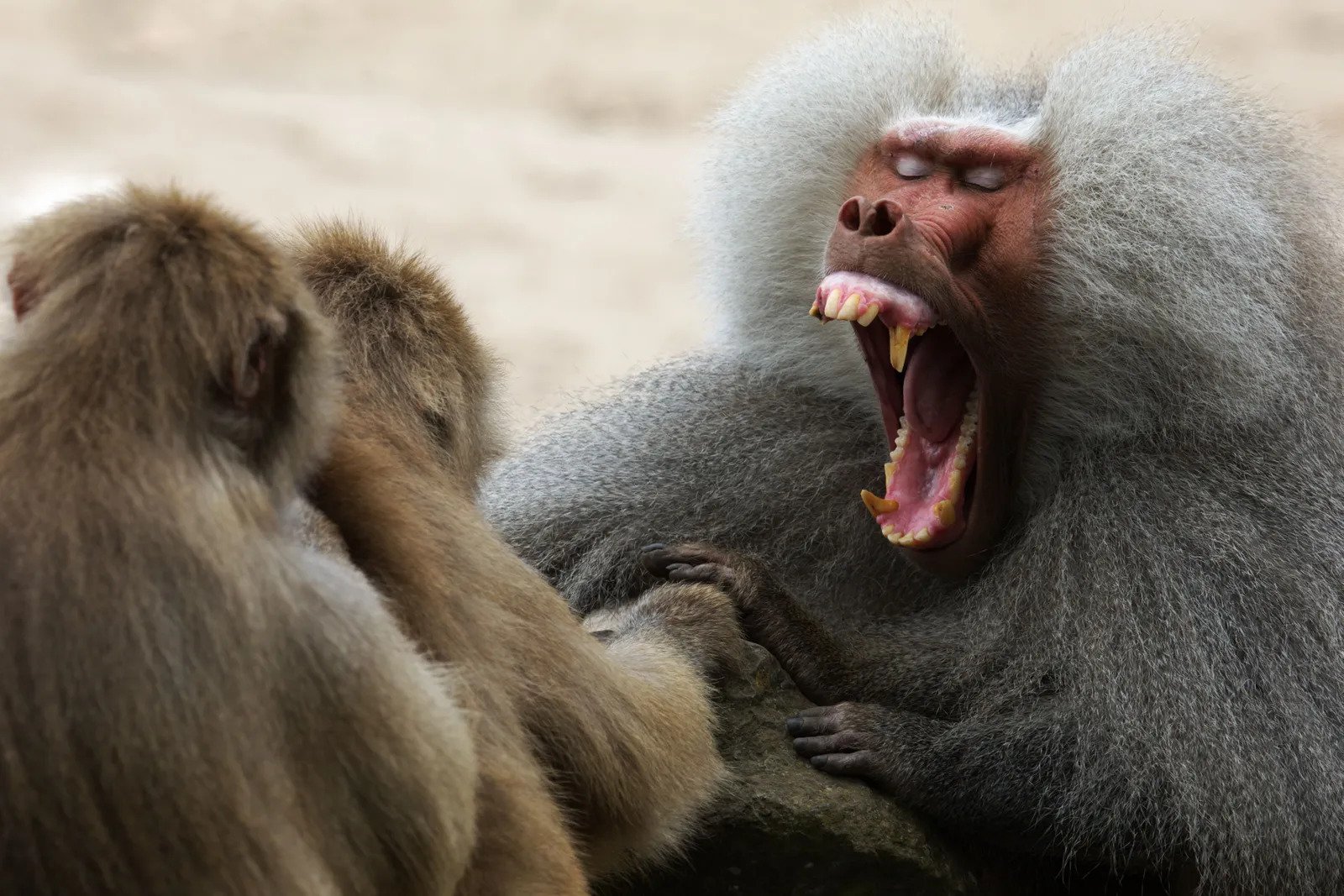
Baboons are a kind of monkey found in Africa and Arabia. Baboons are classified into five species. They may live in a variety of environments, including tropical rainforests, savannas, open woods, and semi-arid places. Baboons are considered pests because they devour a variety of crops. Aside from human conflict, baboons are threatened by habitat loss. One of the five species is classified as nearly threatened (it can become endangered in the near future).
Baboons are known for their complex social behavior. They live in groups called troops and exhibit a range of behaviors, including dominance hierarchies, coalition formation, and grooming alliances. These social interactions help baboons to navigate their environments and find food and mates.
Baboons have very powerful jaws and sharp teeth. Their canine teeth are longer and sharper than those of any other primate, which they use to defend themselves against predators and to forage for food.
Baboons are omnivores and eat a wide variety of foods, including insects, small mammals, birds, fruits, and vegetables. This flexible diet allows baboons to adapt to different environments and survive in challenging conditions.
Some species of baboons, such as the chacma baboon, have been known to engage in raiding behavior. They will break into human homes or gardens to steal food, causing problems for farmers and homeowners in some areas.
Baboons have very colorful and distinct rear ends, which they use to communicate with other members of their troop. These brightly colored buttocks can signal fertility or dominance, and help to reinforce social bonds within the group.
In some cases, baboons have been observed exhibiting altruistic behavior. They may care for injured or sick troop members, or protect vulnerable individuals from predators.
Baboons are known for their ability to adapt to different environments. They can be found living in a variety of habitats, from savannas and forests to mountains and deserts, and have evolved to survive in each of these environments.
Baboons are also known for their impressive physical abilities. They are strong climbers and can jump long distances, which helps them to navigate their environments and find food and shelter.
Baboons are social animals and live in groups called troops. These troops can consist of up to 200 individuals, and are led by dominant males who help to maintain the social order of the group.
Baboons have been the subject of extensive scientific research, particularly in the areas of social behavior, communication, and cognition. They have been shown to possess remarkable intelligence, problem-solving skills, and memory capabilities, which have helped them to survive in challenging environments.
Some species of baboons, such as the hamadryas baboon, have unique social structures. These baboons form harem groups, in which males form strong bonds with females and fiercely defend them from other males.
Baboons have been known to engage in infanticide, which can increase a male’s reproductive success. This behavior is rare, but has been observed in some populations of baboons.
Baboons have been observed using tools, such as using sticks to dig for roots or to fend off predators. This behavior is a sign of their remarkable intelligence and problem-solving abilities.
In some parts of the world, baboons are considered a nuisance or a threat to crops and livestock. They are sometimes culled or hunted for their meat, which is considered a delicacy in some cultures.
Baboons have been featured in many different cultural traditions and mythology. They have appeared in ancient Egyptian art and in the stories of the African Bushmen, and have been an important part of many different cultures throughout history.
Baboons are also a popular subject in wildlife documentaries and nature photography. Their interesting behavior and striking appearance make them a fascinating subject for scientists and nature enthusiasts alike.
Some species of baboons, such as the mandrill, have brightly colored faces. These colors are used to signal the baboon’s health and social status, and can help to attract mates and assert dominance within the group.
Baboons have a wide range of vocalizations that they use to communicate with other members of their troop. These vocalizations include grunts, barks, screams, and even yawns. Scientists have studied these vocalizations to try to understand the complex social relationships that baboons form within their groups.
Baboons have been known to carry and transmit diseases to humans. In particular, the herpes B virus and tuberculosis can be dangerous to humans who come into contact with infected baboons. Researchers are working to better understand how these diseases are transmitted and how to prevent outbreaks from occurring.
Despite their sometimes aggressive behavior and their reputation as pests, baboons are an important part of many ecosystems. They help to maintain the balance of their natural environments by foraging for food, dispersing seeds, and even controlling the populations of certain insect species. As such, it is important to understand and protect these fascinating primates and the habitats in which they live.










Your blog has become a source of inspiration for me. Your writing style is captivating, and your articles consistently offer fresh and valuable perspectives. I appreciate the depth of research and the thoughtfulness you bring to your topics. Keep up the fantastic work!